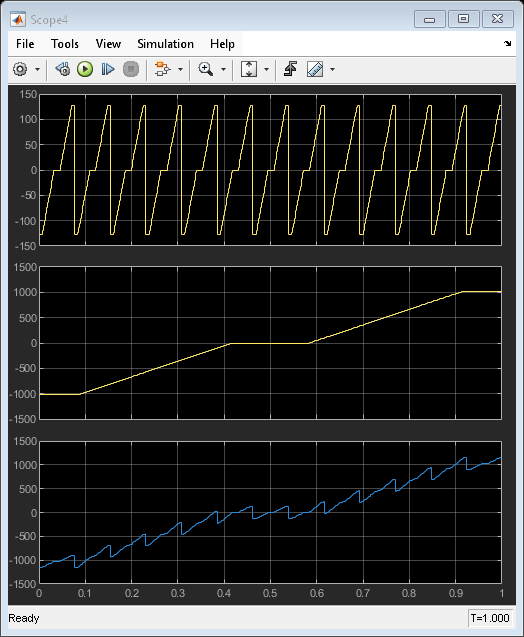Repeating Sequence Interpolated
Output discrete-time sequence and repeat, interpolating between data points
Libraries:
Simulink /
Sources
Description
The Repeating Sequence Interpolated block outputs a periodic discrete-time sequence based on the values in Vector of time values and Vector of output values parameters. Between data points, the block uses the method you specify for the Lookup Method parameter to determine the output.
Examples
Fixed-Point S-Functions: Data Type Propagation
How to propagate fixed-point data types in fixed-point S-Functions. It exercises a custom C language S-function written to enforce data types across multiple signals. This operation is available in Simulink® with the "Data Type Propagation" block, which can be used for comparison with this S-function example.
(Fixed-Point Designer)
Ports
Output
Output signal generated based on the values in the Vector of time values and Vector of output values parameters.
Data Types: single | double | int8 | int16 | int32 | int64 | uint8 | uint16 | uint32 | uint64 | Boolean | fixed point
Parameters
Main
Vector of output values that specify the output waveform. Each element corresponds to the time value in the Vector of time values parameter.
Programmatic Use
Block Parameter:
OutValues |
| Type: character vector |
| Values: vector |
Default: '[3 1 4 2
1].'' |
Specify the column vector containing time values. The time values must be strictly increasing, and the vector must have the same size as the vector of output values.
Programmatic Use
Block Parameter:
TimeValues |
| Type: character vector |
| Values: vector |
Default: '[0 0.1 0.5 0.6
1].'' |
Specify the lookup method to determine the output between data points.
Programmatic Use
Block Parameter:
LookUpMeth |
| Type: character vector |
Values: 'Interpolation-Use End
Values' | 'Use Input Nearest' |
'Use Input Below' | 'Use Input
Above' |
Default:
'Interpolation-Use End Values' |
Specify the time interval between samples. To inherit the sample time,
set this parameter to -1. See Specify Sample Time
for more information.
Programmatic Use
Block Parameter:
tsamp |
| Type: character vector |
| Values: scalar |
Default:
'0.01' |
Signal Attributes
Lower value of the output range that the software checks.
The software uses the minimum to perform:
Parameter range checking (see Specify Minimum and Maximum Values for Block Parameters) for some blocks.
Simulation range checking (see Specify Signal Ranges and Enable Simulation Range Checking).
Automatic scaling of fixed-point data types.
Optimization of the code that you generate from the model. This optimization can remove algorithmic code and affect the results of some simulation modes such as SIL or external mode. For more information, see Optimize using the specified minimum and maximum values (Embedded Coder).
Tips
Output minimum does not saturate or clip the actual output signal. Use the Saturation block instead.
Programmatic Use
To set the block parameter value programmatically, use
the set_param function.
| Parameter: | OutMin |
| Values: | '[]' (default) | scalar in quotes |
Upper value of the output range that the software checks.
The software uses the maximum value to perform:
Parameter range checking (see Specify Minimum and Maximum Values for Block Parameters) for some blocks.
Simulation range checking (see Specify Signal Ranges and Enable Simulation Range Checking).
Automatic scaling of fixed-point data types.
Optimization of the code that you generate from the model. This optimization can remove algorithmic code and affect the results of some simulation modes such as SIL or external mode. For more information, see Optimize using the specified minimum and maximum values (Embedded Coder).
Tips
Output maximum does not saturate or clip the actual output signal. Use the Saturation block instead.
Programmatic Use
To set the block parameter value programmatically, use
the set_param function.
| Parameter: | OutMax |
| Values: | '[]' (default) | scalar in quotes |
Choose the data type for the output. The type can be inherited,
specified directly, or expressed as a data type object such as
Simulink.NumericType.
Programmatic Use
Block Parameter:
OutDataTypeStr |
| Type: character vector |
Values: 'Inherit: Inherit via back
propagation' | 'double' |
'single' | 'int8' |
'uint8' | int16 |
'uint16' | 'int32' |
'uint32' | 'int64' |
'uint64' |
fixdt(1,16,0) |
fixdt(1,16,2^0,0) |
fixdt(1,16,2^0,0). '<data
type expression>' |
Default: 'double' |
Select to lock the output data type setting of this block against changes by the Fixed-Point Tool and the Fixed-Point Advisor. For more information, see Use Lock Output Data Type Setting (Fixed-Point Designer).
Programmatic Use
Block Parameter:
LockScale |
| Type: character vector |
Values:
'off' |
'on' |
Default:
'off' |
Block Characteristics
Data Types |
|
Direct Feedthrough |
|
Multidimensional Signals |
|
Variable-Size Signals |
|
Zero-Crossing Detection |
|
Extended Capabilities
Cannot be used inside a triggered subsystem hierarchy.
PLC Code Generation
Generate Structured Text code using Simulink® PLC Coder™.
Fixed-Point Conversion
Design and simulate fixed-point systems using Fixed-Point Designer™.
Version History
Introduced before R2006a
See Also
MATLAB Command
You clicked a link that corresponds to this MATLAB command:
Run the command by entering it in the MATLAB Command Window. Web browsers do not support MATLAB commands.
Select a Web Site
Choose a web site to get translated content where available and see local events and offers. Based on your location, we recommend that you select: .
You can also select a web site from the following list
How to Get Best Site Performance
Select the China site (in Chinese or English) for best site performance. Other MathWorks country sites are not optimized for visits from your location.
Americas
- América Latina (Español)
- Canada (English)
- United States (English)
Europe
- Belgium (English)
- Denmark (English)
- Deutschland (Deutsch)
- España (Español)
- Finland (English)
- France (Français)
- Ireland (English)
- Italia (Italiano)
- Luxembourg (English)
- Netherlands (English)
- Norway (English)
- Österreich (Deutsch)
- Portugal (English)
- Sweden (English)
- Switzerland
- United Kingdom (English)
